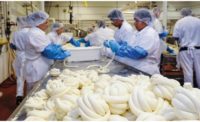Earth day tips for reducing food waste and preventing illness

As the world celebrates Earth Day Friday, USDA is offering tips that both save the environment and money. This spring, the Food Safety and Inspection Service (FSIS) has issued some food safety recommendations to help consumers reduce foodborne illness, resource use, and unnecessary spending for Earth Day.
The USDA’s Economic Research Service (ERS) estimates that the leading 15 foodborne pathogens cost the US economy more than $15 billion annually, because of an estimated 128,000 hospitalizations and 3,000 deaths. In addition to this, ERS estimates that 133 billion pounds of food goes uneaten each year, a loss of approximately $161 billion. Simple actions such as cleaning your oven, allowing your refrigerator to properly circulate air, and downloading the FoodKeeper app can help reduce your risk of foodborne illness, your impact on the environment, and the cost of your bills.
Last year, USDA launched the FoodKeeper app to help combat this cause of waste. The FoodKeeper is available for Apple and Android devices and allows users to set up automatic notifications when foods and beverages are nearing the end of their recommended storage date.
By helping users understand how items should be stored in the refrigerator, freezer, and pantry, the application empowers consumers to choose storage methods that extend the shelf life of their items. It offers advice about more than 400 food and beverage items, including various types of baby food, dairy products, eggs, meat, poultry, produce, seafood, and more. Cooking advice is also offered to ensure users prepare products in ways that eliminate foodborne bacteria.
A refrigerator is your first line of defense in the fight against foodborne illness. Keeping items below 40 ˚F reduces the growth of illness causing pathogens and helps to keep items fresher, longer. But if your refrigerator is over packed, it can cause problems for both your health and your wallet.
An over-packed refrigerator cannot properly circulate air, meaning some storage zones may not be keeping proper temperature. Don't stack foods tightly or cover refrigerator shelves with any material that prevents air circulation from quickly and evenly cooling stored items. Leave at least an inch on all sides of items for cold air to circulate around them, and be sure not to block air vents. Lastly, your kitchen is a high-traffic area where dust accumulates quickly. The front grill of your refrigerator should be kept free of dust and lint to permit free airflow to the unit’s condenser.
Cooking food to a safe internal temperature is the only way to destroy bacteria and other pathogens that can cause foodborne illness.
Whole cuts of beef, pork, lamb and veal should be cooked to 145 °F. For safety and quality, allow meat to rest for at least three minutes before carving or consuming. Ground beef, pork, lamb, and veal should be cooked to 160 °F. All poultry should be cooked to 165 °F.
In addition to offering health benefits, using a food thermometer can prevent overcooking. When using the oven or burners, make sure heating surfaces are clear of food debris. This will ensure an even distribution of energy for optimal heating, also reducing energy costs.
Looking for a reprint of this article?
From high-res PDFs to custom plaques, order your copy today!







